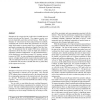Free Online Productivity Tools
i2Speak
i2Symbol
i2OCR
iTex2Img
iWeb2Print
iWeb2Shot
i2Type
iPdf2Split
iPdf2Merge
i2Bopomofo
i2Arabic
i2Style
i2Image
i2PDF
iLatex2Rtf
Sci2ools
SIGMETRICS
1997
ACM
1997
ACM
Performance Issues of Enterprise Level Web Proxies
Enterprise level web proxies relay world-wide web traffic between private networks and the Internet. They improve security, save network bandwidth, and reduce network latency. While the performance of web proxies has been analyzed based on synthetic workloads, little is known about their performance on real workloads. In this paper we present a study of two web proxies (CERN and Squid) executing real workloads on Digital’s Palo Alto Gateway. We demonstrate that the simple CERN proxy architecture outperforms all but the latest version of Squid and continues to outperform cacheless configurations. For the measured load levels the Squid proxy used at least as many CPU, memory, and disk resources as CERN, in some configurations significantly more resources. At higher load levels the resource utilization requirements will cross and Squid will be the one using fewer resources. Lastly we found that cache hit rates of around 30% had very little effect on the requests service time.
| Added | 07 Aug 2010 |
| Updated | 07 Aug 2010 |
| Type | Conference |
| Year | 1997 |
| Where | SIGMETRICS |
| Authors | Carlos Maltzahn, Kathy J. Richardson, Dirk Grunwald |
Comments (0)

